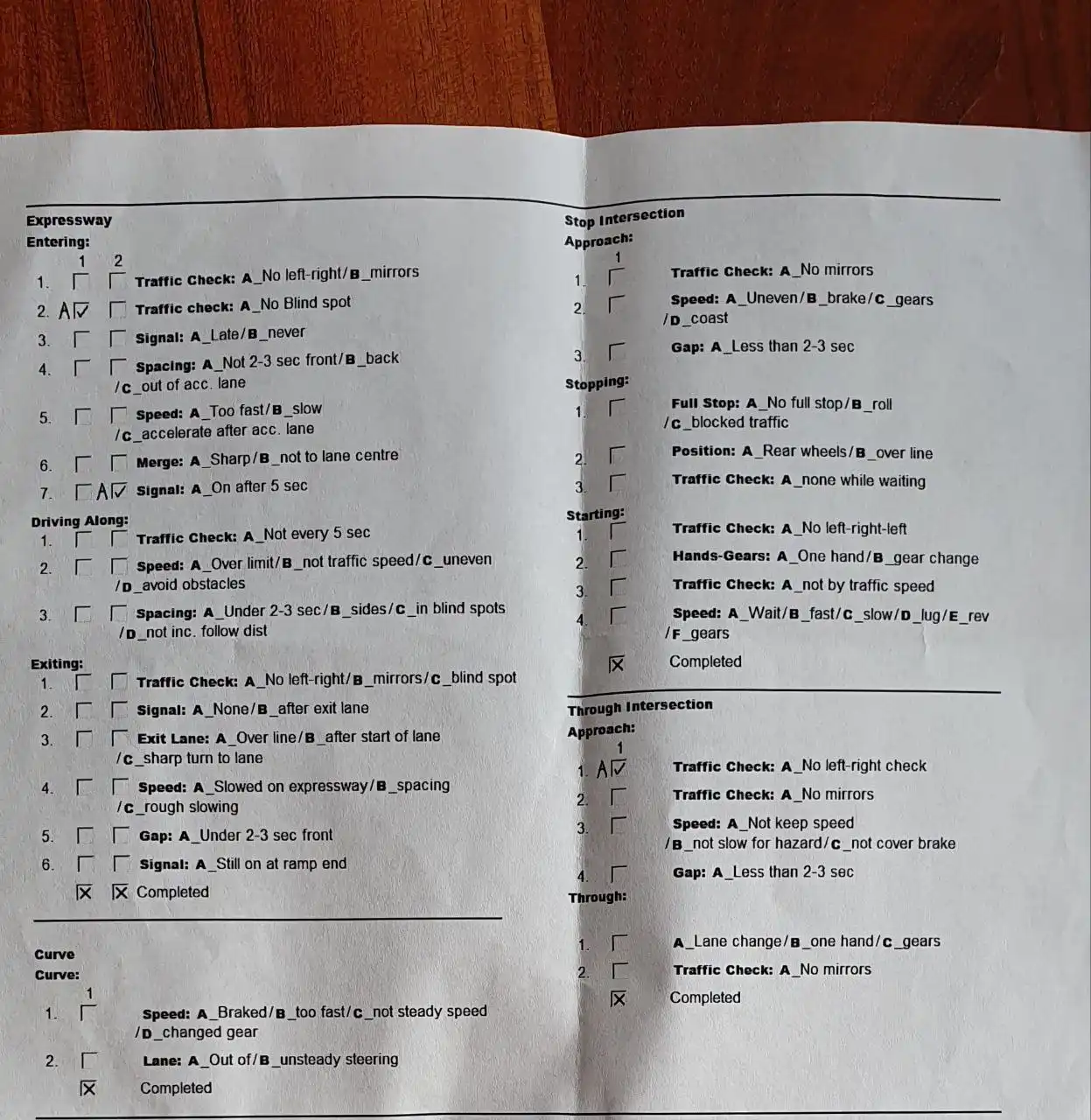How does the examiner evaluate you during the G Full test?
To obtain a full G license in Ontario, you need to pass a road test conducted by a licensed examiner. During the road test, the examiner evaluates your driving skills and ability to follow traffic laws and regulations.

 During the G Full test in Ontario, the examiner evaluates your driving skills and ability to follow traffic laws and regulations. The test is designed to assess your competence in various driving situations and ensure that you can safely operate a motor vehicle on the road.
Here are some key areas the examiner will assess during the G Full test:
Vehicle control: The examiner will observe how well you control the vehicle, including your steering, braking, accelerating, and use of signals. It's important to demonstrate smooth and controlled movements while maintaining proper positioning within your lane.
Observations and awareness: The examiner will evaluate your observation skills and how well you anticipate and respond to potential hazards. This includes checking mirrors, blind spots, and intersections, and properly yielding to other vehicles, pedestrians, and cyclists.
Traffic rules and signs: You will be tested on your knowledge and application of traffic laws, including right-of-way rules, speed limits, lane changes, and proper use of traffic signals and signs.
Lane changing and merging: The examiner will assess your ability to safely change lanes, merge with traffic, and use appropriate signals when necessary. It's crucial to check for other vehicles and make smooth and timely maneuvers.
Intersection management: You will be evaluated on your approach to intersections, including stopping at stop signs, obeying traffic lights, and making proper left and right turns. It's important to signal your intentions, yield to oncoming traffic when necessary, and choose appropriate gaps to enter traffic.
Defensive driving: The examiner will assess your ability to anticipate and react to potential hazards on the road. This includes maintaining a safe following distance, adjusting your speed according to road conditions, and demonstrating courteous and cooperative behavior with other road users.
Emergency maneuvers: In some cases, the examiner may ask you to perform emergency maneuvers, such as a quick stop or evasive lane change. These tests evaluate your ability to respond effectively in unexpected situations.
The examiner will use a standardized scoring system to evaluate your performance throughout the test. It's essential to demonstrate safe and responsible driving practices, follow instructions, and maintain composure during the examination. Remember to practice defensive driving techniques, stay calm, and always prioritize safety.
During the G Full test in Ontario, the examiner evaluates your driving skills and ability to follow traffic laws and regulations. The test is designed to assess your competence in various driving situations and ensure that you can safely operate a motor vehicle on the road.
Here are some key areas the examiner will assess during the G Full test:
Vehicle control: The examiner will observe how well you control the vehicle, including your steering, braking, accelerating, and use of signals. It's important to demonstrate smooth and controlled movements while maintaining proper positioning within your lane.
Observations and awareness: The examiner will evaluate your observation skills and how well you anticipate and respond to potential hazards. This includes checking mirrors, blind spots, and intersections, and properly yielding to other vehicles, pedestrians, and cyclists.
Traffic rules and signs: You will be tested on your knowledge and application of traffic laws, including right-of-way rules, speed limits, lane changes, and proper use of traffic signals and signs.
Lane changing and merging: The examiner will assess your ability to safely change lanes, merge with traffic, and use appropriate signals when necessary. It's crucial to check for other vehicles and make smooth and timely maneuvers.
Intersection management: You will be evaluated on your approach to intersections, including stopping at stop signs, obeying traffic lights, and making proper left and right turns. It's important to signal your intentions, yield to oncoming traffic when necessary, and choose appropriate gaps to enter traffic.
Defensive driving: The examiner will assess your ability to anticipate and react to potential hazards on the road. This includes maintaining a safe following distance, adjusting your speed according to road conditions, and demonstrating courteous and cooperative behavior with other road users.
Emergency maneuvers: In some cases, the examiner may ask you to perform emergency maneuvers, such as a quick stop or evasive lane change. These tests evaluate your ability to respond effectively in unexpected situations.
The examiner will use a standardized scoring system to evaluate your performance throughout the test. It's essential to demonstrate safe and responsible driving practices, follow instructions, and maintain composure during the examination. Remember to practice defensive driving techniques, stay calm, and always prioritize safety.

 During the G Full test in Ontario, the examiner evaluates your driving skills and ability to follow traffic laws and regulations. The test is designed to assess your competence in various driving situations and ensure that you can safely operate a motor vehicle on the road.
Here are some key areas the examiner will assess during the G Full test:
Vehicle control: The examiner will observe how well you control the vehicle, including your steering, braking, accelerating, and use of signals. It's important to demonstrate smooth and controlled movements while maintaining proper positioning within your lane.
Observations and awareness: The examiner will evaluate your observation skills and how well you anticipate and respond to potential hazards. This includes checking mirrors, blind spots, and intersections, and properly yielding to other vehicles, pedestrians, and cyclists.
Traffic rules and signs: You will be tested on your knowledge and application of traffic laws, including right-of-way rules, speed limits, lane changes, and proper use of traffic signals and signs.
Lane changing and merging: The examiner will assess your ability to safely change lanes, merge with traffic, and use appropriate signals when necessary. It's crucial to check for other vehicles and make smooth and timely maneuvers.
Intersection management: You will be evaluated on your approach to intersections, including stopping at stop signs, obeying traffic lights, and making proper left and right turns. It's important to signal your intentions, yield to oncoming traffic when necessary, and choose appropriate gaps to enter traffic.
Defensive driving: The examiner will assess your ability to anticipate and react to potential hazards on the road. This includes maintaining a safe following distance, adjusting your speed according to road conditions, and demonstrating courteous and cooperative behavior with other road users.
Emergency maneuvers: In some cases, the examiner may ask you to perform emergency maneuvers, such as a quick stop or evasive lane change. These tests evaluate your ability to respond effectively in unexpected situations.
The examiner will use a standardized scoring system to evaluate your performance throughout the test. It's essential to demonstrate safe and responsible driving practices, follow instructions, and maintain composure during the examination. Remember to practice defensive driving techniques, stay calm, and always prioritize safety.
During the G Full test in Ontario, the examiner evaluates your driving skills and ability to follow traffic laws and regulations. The test is designed to assess your competence in various driving situations and ensure that you can safely operate a motor vehicle on the road.
Here are some key areas the examiner will assess during the G Full test:
Vehicle control: The examiner will observe how well you control the vehicle, including your steering, braking, accelerating, and use of signals. It's important to demonstrate smooth and controlled movements while maintaining proper positioning within your lane.
Observations and awareness: The examiner will evaluate your observation skills and how well you anticipate and respond to potential hazards. This includes checking mirrors, blind spots, and intersections, and properly yielding to other vehicles, pedestrians, and cyclists.
Traffic rules and signs: You will be tested on your knowledge and application of traffic laws, including right-of-way rules, speed limits, lane changes, and proper use of traffic signals and signs.
Lane changing and merging: The examiner will assess your ability to safely change lanes, merge with traffic, and use appropriate signals when necessary. It's crucial to check for other vehicles and make smooth and timely maneuvers.
Intersection management: You will be evaluated on your approach to intersections, including stopping at stop signs, obeying traffic lights, and making proper left and right turns. It's important to signal your intentions, yield to oncoming traffic when necessary, and choose appropriate gaps to enter traffic.
Defensive driving: The examiner will assess your ability to anticipate and react to potential hazards on the road. This includes maintaining a safe following distance, adjusting your speed according to road conditions, and demonstrating courteous and cooperative behavior with other road users.
Emergency maneuvers: In some cases, the examiner may ask you to perform emergency maneuvers, such as a quick stop or evasive lane change. These tests evaluate your ability to respond effectively in unexpected situations.
The examiner will use a standardized scoring system to evaluate your performance throughout the test. It's essential to demonstrate safe and responsible driving practices, follow instructions, and maintain composure during the examination. Remember to practice defensive driving techniques, stay calm, and always prioritize safety.





